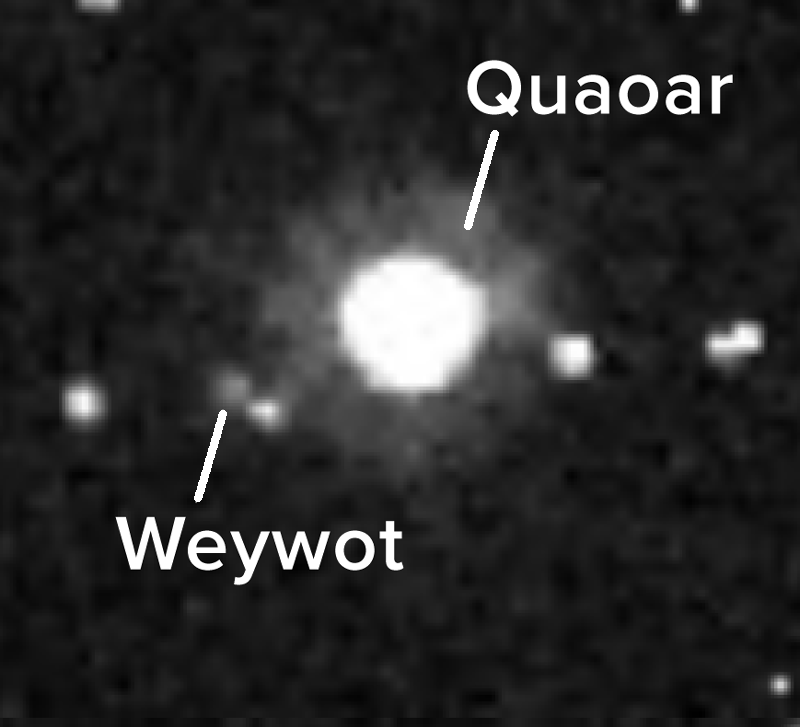A small world in the outer solar system has a ring that shouldn’t exist. According to new research, the ring material around the dwarf planet Quaoar is far enough away from the body that it should have coalesced into a moon but, for some reason, hasn’t.
This gravity-defying ring could prompt astronomers to reexamine the physics of ring and moon formation and provide insight into the interactions between objects beyond Neptune. The researchers published their result in Nature.
A Rule Breaker
The solar system beyond Neptune is home to several dwarf planets and numerous small icy objects left over from planet formation. These objects interact gravitationally with each other, sometimes in violent collisions that create a cloud of debris that will often flatten into a disk.
“Rings seem to be a natural outcome during the evolution of these bodies.”
That object’s mass, and therefore gravity, governs what happens next. Outside a theoretical boundary known as the Roche limit, that disk has the gravitational freedom to coalesce into a moon. Inside the Roche limit, however, gravity will shepherd the disk into a narrow ring, but the central body’s tidal forces prevent the ring from becoming a moon. The rings of Jupiter, Saturn, Uranus, Neptune, and several dwarf planets all follow this rule.
“Rings seem to be a natural outcome during the evolution of these bodies,” said Bruno Sicardy, an astronomer at Sorbonne Université in Paris and a coauthor of the research.
Quaoar is a 1,110-kilometer-wide dwarf planet that orbits beyond Pluto in a region of the solar system called the Kuiper belt. Discovered in 2002, astronomers later found that it has a moon, Weywot, and likely has water ice on its surface from active ice volcanism.
Astronomers were trying to better map Quaoar’s shape—it’s not quite spherical—using the European Space Agency’s (ESA) Characterising Exoplanet Satellite (CHEOPS). They were looking for stellar occultations, a phenomenon in which a nearby object of interest (Quaoar in this case) blocks distant background starlight. Instead, they discovered that something also was blocking starlight on either side of the dwarf planet. Additional archival observations from 2018 to 2021 and computational models suggested that those occultations were likely from a thin circular ring of material 4,100 kilometers (2,500 miles) away from Quaoar.
Quaoar isn’t the first dwarf planet to host rings, Sicardy said. “As there are thousands of such bodies beyond Neptune, we expected that rings should be commonplace in this region of the solar system.” The rings of Chariklo, which started life in the Kuiper belt before Chariklo migrated inward toward Saturn, were discovered in 2013, and Haumea’s rings were found in 2017. “And now, around Quaoar,” he added.
The difference with Quaoar’s ring, however, is that it lives far outside Quaoar’s Roche limit, so it should have become a moon.
Too Coincidental
Michael Brown, an astronomer at the California Institute of Technology who helped discover Quaoar in 2002 but was not involved with this research, told the New York Times, “If the data weren’t so convincing, I would insist they weren’t real.”
If this ring is on its way to becoming a moon…then it’s improbably lucky that the researchers spotted it.
It’s possible that Quaoar’s ring might eventually form a moon, but it’s not very likely. Because of Quaoar’s weak tidal forces, such a ring outside the Roche limit should coalesce into a moon within a year or so of the debris field forming, Sicardy said. In the billions-of-years-long life span of Quaoar, that’s less than a blink of an eye. If this ring is on its way to becoming a moon, as the Roche limit theory insists, then it’s improbably lucky that the researchers spotted it, he explained.
Beyond the possibility of coincidence, the team has a few ideas that could explain the ring’s survival beyond the Roche limit. It’s possible that because we don’t know Quaoar’s shape very well, its Roche limit might be different than expected.

The team, however, believes that a stable gravitational resonance near the ring’s orbit might prevent the ring particles from coalescing. Moreover, the ring’s icy particles might be more elastic than expected, so they bounce off each other rather than sticking together to create ever larger clumps that eventually make a satellite. The Roche limit, the team concluded, is likely more complicated than previously thought.
The team plans to continue observing the Quaoar system using stellar occultations to better characterize the ring and see whether it evolves over time, Sicardy said. Quaoar, its ring, and its moon, Weywot, are small, dim, and far away, which makes them challenging to see with advanced ground- and space-based telescopes. “However,” he added, “these images may reveal more extended rings and small satellites that will tell us more about Quaoar’s—and other bodies’—environments.”
—Kimberly M. S. Cartier (@AstroKimCartier), Staff Writer

